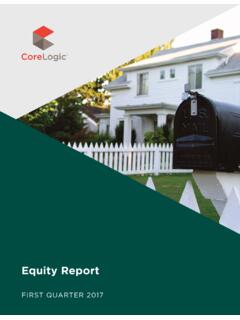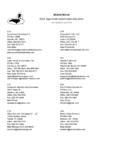Transcription of Catastrophe Risk Management - CoreLogic
1 Catastrophe Risk Management1 Complete. Current. LARSENHow will Catastrophe modeling be used in the insurance enterprise of the future? Catastrophe modeling is a profound technology that has re-shaped the property insurance and re-insurance industries. The evidence is compelling: in 1992, losses from Hurricane Andrew pushed eight insurance companies into insolvency, and several others became technically insolvent, requiring the transfer of funds from parent companies1. In 2005, Hurricane Katrina became the largest insured catastrophic loss in history with far less market disruption and insolvency despite following the dramatic 2004 hurricane loss year. While the science of Catastrophe modeling is still working to improve the precision and accuracy of models, the presence and usage of Catastrophe models was beneficial: improving the financial strength of insurers and consequently providing policy holder compensation for losses incurred from this modeling has become ubiquitous in the property insurance industry.
2 Catastrophe models are embedded into the enterprise risk Management practice of insurance companies globally, extending into underwriting and claims Management for some of the most Catastrophe -prone re-insurers. Analytic risk modeling outputs of Catastrophe models have supported the development of the property Catastrophe Insurance Linked Securities (ILS) market which has become very important in today s low interest environment. After contributing significantly to processes and market discipline, the next act of Catastrophe modeling in the insurance environment will be to most profound technologies are those that disappear. They weave themselves into the fabric of everyday life until they are indistinguishable from fundamental insights from Catastrophe modeling will be extended throughout the insurance organization, encompassing underwriting and claims as well as enterprise risk Management .
3 Efficiently introducing Catastrophe modeling throughout the organization will leverage business process technology and deliver the information advantage that insurers first generation of Catastrophe modeling required re/insurance companies to adapt to the vagaries of models gathering risk attribute data (location, construction, occupancy, policy terms and conditions) that often extended beyond the level of data that they had captured. Incomplete model connectivity has led to uncertain integration points and conflict between Catastrophe models and business processes, Management strategy and technology. The next generation of Catastrophe models will be aligned with insurers business processes to help meet their business objectives and recognize the business needs of broadening Catastrophe risk Management into their underwriting, actuarial and claims activities.
4 Moving the Catastrophe model outside of the risk Management group has been expensive and proven to be a barrier to integration. 1. Insurance Information Institute, Hurricane Andrew and Insurance: The enduring impact of an historic storm , August 20122. Weiser, M. The Computer for the 21st Century , Scientific American, 19912 Leveraging grid-scale performance, web-services, access to real-time property data and characteristic assets and broadening the perils and how perils are managed delivers a comprehensive view of risk. The different activities in an insurance company (underwriting, enterprise risk Management , claims) have different focuses varying from top down (broad and general) to bottom-up (narrow and specific) but the perils that are managed are the same and systems should reflect catastrophes remain perhaps the most poignant risks to the operations of an insurance company, and the first generation of Catastrophe models helped insurers quantify this risk.
5 But the first generation of Catastrophe modeling for insurers and reinsurers required the adoption of the insurance enterprise to new analytical models that quantified risk. For some insurers, this required the introduction of Catastrophe modeling statistics into their Management and control systems producing a system that was difficult to maintain. For other insurers, the Catastrophe model became the spine of their enterprise risk Management system and their business was effectively controlled by their model vendor. The next generation of Catastrophe modeling will include a story of business process integration. The early adopters of Catastrophe models were focused upon capitalizing on information asymmetry having more information than their policy holders and competition delivered an early-adopter return on the investment. In 2016 both of these advantages have eroded and the follow-up generation of Catastrophe models deliver the operational efficiency to minimize adverse selection and moral his story The Old Man and the Sea , Ernest Hemingway guides us with the thought Now is no time to think of what you do not have.
6 Think of what you can do with that there is . The next story of Catastrophe modeling embraces the linkage of information we have today into a unified body to improve our ability to manage and react to Catastrophe occurrences. Ideas of the future that are powered by our ability to record, store and analyze data include: A real-time underwriting workflow will include the track record of a building a record of the Catastrophe events that have affected it (for example: hail size and date; or earthquake event and local ground motions). Claims processing will incorporate automatic event hazard footprint evaluations defensively, improving the fraud detection efforts of insurers but also enabling a pro-active policy holder engagement that does not have to wait for the First Notice of Loss. Verifiable validate reconstruction valuation estimates, property information available from public sources such as assessor s and building permit databases improving the quality of Catastrophe modeling output by reducing the uncertainty of the inputs.
7 Business process integration using web-services, local network or cloud-based computer and uniform data standards empower the insurer by enabling real-time Catastrophe loss estimation and Management in the will maintain the information advantage with a complete set of insurance data: uncertainty will be lowered with the addition of risk characteristics such as reconstruction cost, assessor s and building permit risk information that are available at the time of underwriting. Connecting to the software will rely upon straight-through processing with computing hosted locally and remotely. Simulation model outputs will enable integration into Management reporting without costly adaptations of underwriting systems for the idiosyncrasies of first generation cat models. Simpler interoperability of Catastrophe models with existing underwriting, claims and Management systems will enable a more current view of risk with simpler integration of scientific changes to the models.
8 The next generation of Catastrophe models will connect the entire insurance enterprise: underwriting, enterprise risk and claims Management with fast and integrated underwriting risk scores, probabilistic loss modeling and immediate post-event hazard footprints for claims efficiency. 4 Breaking the Code: Diving into the Earthquake Model UpdateMAICLAIRE BOLTONC atastrophe risk Management is grounded on forecasting and evaluating risks , and identifying options to minimize their impact with the goal of assessing risk for adequate allocation of resources and capital reserves. It is essential to not only understand what can happen, but be prepared for the unknown. Peter Drucker summarizes this concept well with his infamous statement: In an organization, there is no such thing as a pleasant surprise. This is increasingly relevant in Catastrophe risk Management .
9 One of the greatest anxieties risk managers possess is the unknown or the surprises. While natural Catastrophe losses can be volatile, they are manageable and it is feasible to account for surprises with rational, credible models to capture these surprises. Earthquake Catastrophe risk Management , historically, has been a balance between the probabilistic risk curve and capital allocation based upon a single earthquake event. While a single event provides a clear risk, it is not a complete view of the risk and doesn t provide the full picture. To go beyond the standard risk curve to identify the full probabilistic risk curve, it is necessary to investigate further and understand where the risk is focused by considering the drivers of risk Management , through models and business solutions, is informed by the combination of the latest science with the latest technology.
10 The better these two components are understood, the more confident risk managers can be in their decisions. For risk managers to be as effective as possible, it is critical to be on the leading edge of technology with solutions to not only manage their risk, but to provide added insight into the risk. Additionally, there is a balance between understanding the science and technology with Management clarity and direction. As science and technology evolve, so must the way risk is managed. The Earthquake Model from CoreLogic provides risk managers with a sophisticated tool to drive more enlightened risk Management decisions. As a trusted advisor, CoreLogic provides leading edge solutions to minimize the financial impact of the Leading EdgeBusiness solutions for Catastrophe risk Management strive to mimic a risk, as close to reality as possible.
















![[PUBLISH] IN THE UNITED STATES COURT OF APPEALS FOR …](/cache/preview/0/7/3/4/8/4/4/6/thumb-07348446070f9a9adbdc796d3164ec9c.jpg)


